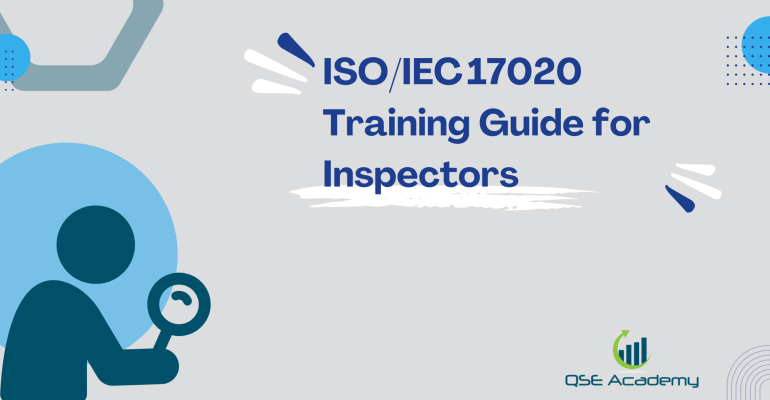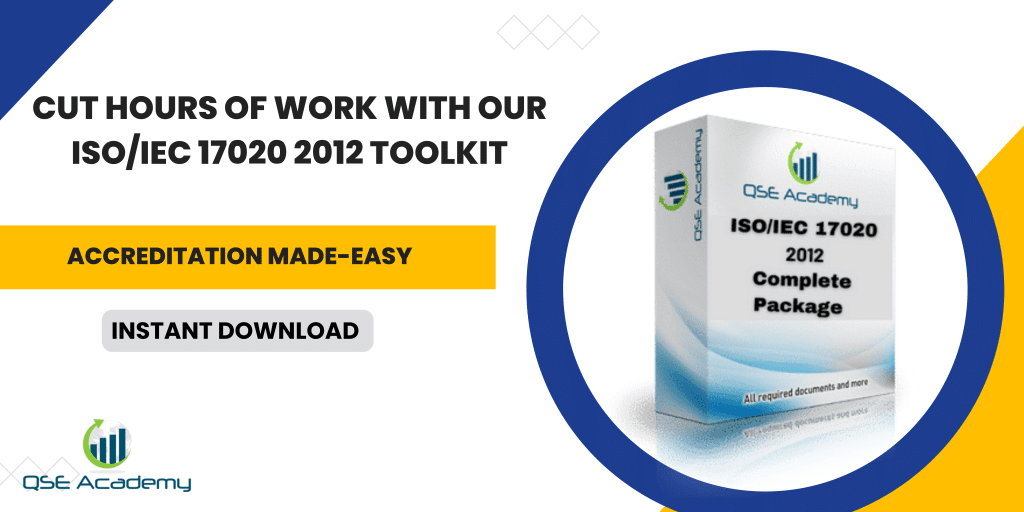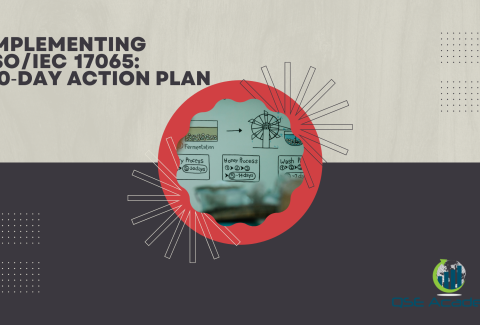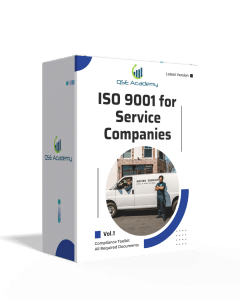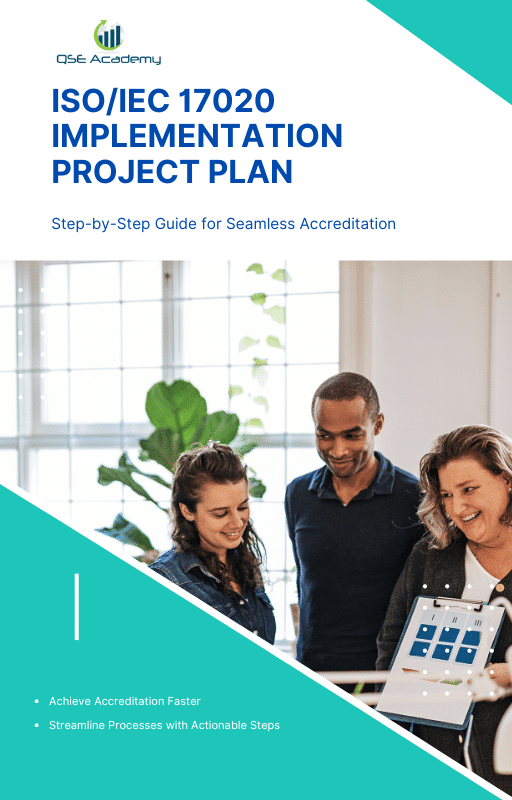ISO/IEC 17020 Training Guide for Inspectors
Last Updated on October 22, 2025 by Hafsa J.
Why Inspector Training Matters for ISO/IEC 17020 Accreditation
Every inspection body wants competent, confident inspectors — but few realize how central training is to ISO/IEC 17020 compliance.
I’ve seen organizations with great technical teams fail audits simply because they couldn’t prove that their inspectors were trained, evaluated, and authorized correctly.
That’s the real point of ISO/IEC 17020 training: it’s not just about knowing how to inspect — it’s about demonstrating that competence through evidence.
In this guide, I’ll walk you through how to:
-
Build a structured ISO/IEC 17020 training program.
-
Assess inspector competence in practical, measurable ways.
-
Keep training records organized so auditors can verify them instantly.
By the end, you’ll know exactly what “competence” means in the eyes of ISO/IEC 17020 — and how to build a training system that proves it.
Understanding Competence Requirements Under ISO/IEC 17020
When ISO/IEC 17020 talks about “competence,” it’s not just referring to technical know-how. It’s a combination of knowledge, behavior, and consistency — the ability to perform inspections correctly every single time.
Here’s how I usually break it down for clients:
-
General competence covers the fundamentals — understanding ISO/IEC 17020 requirements, impartiality, confidentiality, and ethics. Inspectors should know not just what to do, but why it matters.
-
Technical competence focuses on the actual inspection work — applying methods, using equipment, evaluating results, and making sound technical judgments.
Both areas matter equally. An inspector who’s technically brilliant but doesn’t understand impartiality can cause nonconformities just as quickly as one who lacks method-specific training.
During audits, assessors often check:
-
Whether your inspectors know the limits of their authorization.
-
How consistently they apply inspection methods.
-
If their training and qualifications match your documented competence requirements.
Pro Tip: Map each competence to a measurable outcome. For example, “Inspector demonstrates correct use of ultrasonic testing equipment” is easier to verify than “Inspector understands testing equipment.”
Common Pitfall: Relying only on years of experience as proof of competence. ISO/IEC 17020 requires objective evidence — not assumptions.
Designing an ISO/IEC 17020 Training Program (Structure & Stages)
A solid training program isn’t just about checking boxes — it’s about building consistency and confidence in every inspector’s work.
What I’ve noticed is that inspection bodies that structure their training in stages perform better during audits and retain staff longer. People know what’s expected and how to grow into new scopes.
Here’s a simple structure that works for most organizations:
Stage 1: Induction & Foundation Training
This is where every new inspector starts.
Cover the essentials — ISO/IEC 17020 overview, impartiality, confidentiality, and the inspection body’s policies.
It sets the tone and ensures everyone understands the organization’s ethical and procedural baseline.
Stage 2: Technical Training
Once the basics are covered, focus on the technical side — inspection methods, use of equipment, sampling, safety, and report writing.
This is usually a mix of classroom sessions and on-site demonstrations.
Pro Tip: Pair new inspectors with experienced ones for hands-on learning. It’s the fastest way to transfer real-world knowledge.
Stage 3: Assessment & Authorization
Training isn’t complete until competence is demonstrated.
That’s where witnessed inspections come in — supervisors observe inspectors performing actual tasks, evaluating both technique and judgment.
Only after successful evaluation should authorization be granted.
Common Pitfall: Stopping after theoretical training. ISO/IEC 17020 expects training to lead to measurable competence, not just attendance certificates.
Each stage should build upon the last, creating a clear path from beginner to fully authorized inspector.
Building and Maintaining a Competence Matrix
Once your training program is in place, you need a way to show auditors that each inspector is competent for the tasks they perform.
That’s where the competence matrix comes in — it’s your proof that training has turned into measurable competence.
Think of it as a living dashboard of your team’s skills. Each row represents an inspector, and each column shows the competencies they’ve achieved.
Here’s what to include:
-
Inspector’s name and position.
-
Areas of competence (technical, quality, reporting).
-
Relevant training completed (with dates).
-
Results of witnessed assessments or evaluations.
-
Authorized scopes of inspection.
Pro Tip: Keep it digital. A well-maintained spreadsheet or software-based matrix makes it easy to update and retrieve during audits.
Accreditation assessors often ask, “Can you show me which inspectors are qualified for this type of inspection?” — your matrix should answer that in seconds.
Common Pitfall: Letting the matrix go stale. Update it after every training session, re-evaluation, or scope change. Outdated records send the message that training isn’t actively managed.
When done right, your competence matrix isn’t just a record — it becomes a management tool that helps allocate the right people to the right jobs.
Conducting Witnessed Assessments & Evaluations
Training proves knowledge — but witnessed assessments prove performance.
This is where you evaluate how inspectors actually apply what they’ve learned in real situations.
During a witnessed assessment, a qualified evaluator observes the inspector performing an inspection task. The goal isn’t to catch mistakes but to confirm that procedures, safety practices, and technical methods are applied correctly and consistently.
Here’s what assessors usually look for:
-
Preparation: Does the inspector review the inspection criteria and checklists before starting?
-
Execution: Are they following procedures step by step?
-
Communication: How do they interact with clients or site personnel?
-
Reporting: Is their documentation clear, accurate, and traceable?
Pro Tip: Use a standardized witnessed-inspection form. It keeps evaluations consistent across departments and inspectors.
One inspection body I worked with introduced peer-to-peer assessments — senior inspectors would observe juniors once a month. Within six months, report errors dropped by 40%. Small improvements like that make a big difference during accreditation.
Common Pitfall: Treating witnessed assessments as a one-time event. ISO/IEC 17020 expects continual evaluation, especially when procedures, equipment, or personnel change.
When done regularly, witnessed assessments don’t just check competence — they build confidence. Inspectors know they’re supported, not just monitored.
Documentation & Recordkeeping for Training and Competence
Here’s something auditors consistently look for — proof of training and competence.
You can have the best program in the world, but if you can’t produce records instantly, it’s as if it never happened.
That’s why documentation is non-negotiable. Every piece of training and every evaluation should leave a clear, traceable record.
Here’s what your training records should include:
-
Training attendance sheets – signed by the trainer and participants.
-
Certificates or qualifications – internal or external, dated, and linked to the relevant scope.
-
Witnessed assessment reports – showing who observed, what was evaluated, and the outcome.
-
Authorization letters – confirming which inspections each person is approved to perform.
Pro Tip: Maintain a training summary sheet for each inspector — one page showing all training, assessments, and authorizations. Assessors love this because it saves them from flipping through piles of documents.
Keep these records organized in your document-control system. Whether it’s a shared drive or a QMS software, they should be easily retrievable during audits.
Common Pitfall: Losing evidence in scattered folders. Consolidate your training documents in one dedicated section of your management system. It makes both internal audits and accreditation assessments far smoother.
Your documentation is your story — it shows how your inspectors became competent, step by step.
Continuous Professional Development (CPD) for Inspectors
Training doesn’t end once an inspector is authorized. Competence isn’t permanent — it fades if it isn’t refreshed.
That’s why Continuous Professional Development (CPD) is essential under ISO/IEC 17020.
Think of CPD as your way to keep inspectors sharp, confident, and up-to-date with new methods or standards. It’s not just about formal courses; it’s about ongoing learning in every form.
Here are some simple but effective CPD activities:
-
Attending technical seminars, workshops, or industry conferences.
-
Joining internal refresher sessions or toolbox meetings.
-
Reviewing updated inspection procedures or standards.
-
Participating in internal audits or peer evaluations.
-
Shadowing inspections in new scopes to broaden experience.
Pro Tip: Create a CPD tracker for each inspector. List every activity — even short internal sessions — with dates and learning outcomes. Auditors appreciate seeing growth documented over time.
Common Pitfall: Assuming experienced inspectors don’t need CPD. Everyone benefits from periodic refreshers, especially when inspection methods or client requirements evolve.
The most successful inspection bodies I’ve worked with treat CPD as part of their culture, not a compliance task. Their inspectors don’t just meet the standard — they stay ahead of it.
Creating a Culture of Competence and Accountability
Even the best training program won’t last if competence isn’t part of your organization’s culture.
In ISO/IEC 17020, competence isn’t just a document — it’s a mindset. It’s how your inspectors think, act, and take ownership of their work every day.
Here’s what that looks like in practice:
-
Management leads by example. Leaders talk about competence during meetings, not just compliance.
-
Inspectors share knowledge. Senior staff mentor juniors, passing on lessons that no manual can teach.
-
Accountability is clear. Everyone knows their role, their scope, and what’s expected of them.
One inspection body I worked with paired new inspectors with senior ones for three months. The result? Fewer report errors, smoother inspections, and stronger team cohesion. That’s what happens when competence becomes part of your daily rhythm, not a once-a-year checklist.
Pro Tip: Recognize training achievements publicly — small acknowledgments go a long way in reinforcing accountability and pride in professional growth.
Common Pitfall: Treating training as HR’s responsibility alone. In a truly competent inspection body, every manager and senior inspector plays a role in developing others.
When everyone contributes to competence, your organization becomes not just compliant — but capable, consistent, and respected.
FAQs – Common Questions About Inspector Training
Q1: How often should inspectors be re-evaluated for competence?
At least once a year, or whenever something significant changes — like a new inspection method, updated procedure, or new equipment.
Re-evaluations aren’t just about ticking boxes; they confirm that inspectors remain confident and consistent in their roles.
Q2: Can online courses or e-learning count as ISO/IEC 17020 training?
Yes — as long as the course content matches your required competencies and is supported by practical verification.
For example, an online course on inspection methods is great, but it should be followed by a witnessed assessment to prove application.
Q3: What training evidence do assessors usually request during accreditation audits?
Auditors typically ask for:
-
Your training plan or schedule.
-
Competence matrix showing who’s qualified for what.
-
Witnessed inspection records confirming technical performance.
-
Authorization letters verifying final approval to conduct inspections.
Pro Tip: Make sure your evidence is consistent — training records, competence evaluations, and authorizations should all align. If one says an inspector is qualified for electrical inspections, the others should back that up.
Clear, traceable documentation makes assessors’ questions easy to answer — and your audit experience much smoother.
Turning Training Into Long-Term Competence
ISO/IEC 17020 doesn’t just ask for training — it demands proof that your inspectors are competent, consistent, and continually improving.
That’s why a structured training program isn’t just compliance work; it’s your competitive edge.
In my experience, the inspection bodies that excel aren’t the ones with the thickest manuals — they’re the ones that invest in people.
They train deliberately, evaluate regularly, and keep growing their team’s competence year after year.
When you treat training as an ongoing system — not a one-time event — you create inspectors who don’t just follow procedures; they understand them, own them, and apply them with confidence.
Key takeaway:
Competence isn’t something you prove once to an assessor; it’s something you build daily through consistent learning, evaluation, and accountability.
Next Step:
Download the ISO/IEC 17020 Training Matrix Template or connect with QSE Academy to design a customized inspector training program that meets every clause of ISO/IEC 17020 — and sets your team up for long-term success.
I hold a Master’s degree in Quality Management, and I’ve built my career specializing in the ISO/IEC 17000 series standards, including ISO/IEC 17025, ISO 15189, ISO/IEC 17020, and ISO/IEC 17065. My background includes hands-on experience in accreditation preparation, documentation development, and internal auditing for laboratories and certification bodies. I’ve worked closely with teams in testing, calibration, inspection, and medical laboratories, helping them achieve and maintain compliance with international accreditation requirements. I’ve also received professional training in internal audits for ISO/IEC 17025 and ISO 15189, with practical involvement in managing nonconformities, improving quality systems, and aligning operations with standard requirements. At QSE Academy, I contribute technical content that turns complex accreditation standards into practical, step-by-step guidance for labs and assessors around the world. I’m passionate about supporting quality-driven organizations and making the path to accreditation clear, structured, and achievable.

